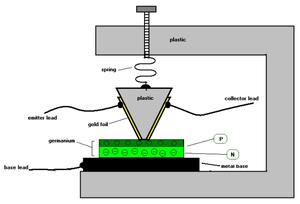A point-contact transistor was the first type of solid-state electronic transistor ever constructed. It was made by researchers John Bardeen and Walter Houser Brattain at Bell Laboratories in December 1947. They worked in a group led by physicist William Bradford Shockley. The group had been working together on experiments and theories of electric field effects in solid state materials, with the aim of replacing vacuum tubes with a smaller, less power-consuming device.The critical experiment, carried out on December 16, 1947, consisted of a block of germanium, a semiconductor, with two very closely spaced gold contacts held against it by a spring. Brattain attached a small strip of gold foil over the point of a plastic triangle — a configuration which is essentially a point-contact diode. He then carefully sliced through the gold at the tip of the triangle. This produced two electrically isolated gold contacts very close to each other.The piece of germanium used had a surface layer with an excess of electrons. When an electric signal traveled in through the gold foil, it injected holes (points which lack electrons). This created a thin layer which had a scarcity of electrons.A small positive current applied to one of the two contacts had an influence on the current which flowed between the other contact and the base upon which the block of germanium was mounted. In fact, a small change in the first contact current, caused a greater change in the second contact current, thus it was an amplifier. The first contact is the "emitter" and the second contact is the "collector". The low-current input terminal into the point-contact transistor is the emitter, while the output high current terminals are the base and collector. This differs from the later type of bipolar junction transistor invented in 1951 that operates as transistors still do, with the low current input terminal as the base and the two high current output terminals are the emitter and collector.Unlike later semiconductor devices, it was possible for an amateur to make a point-contact transistor, starting with a germanium point-contact diode as a source of material (even a burnt-out diode could be used; and the transistor could be re-formed if damaged, several times if necessary).The point-contact transistor was commercialized and sold by Western Electric and others but was soon superseded by the bipolar junction transistor, which was easier to manufacture and more rugged. Germanium was employed extensively for two decades in the manufacture of transistors, but was then almost totally replaced by silicon and other alloyed materials. As of 2012 germanium point-contact diodes continued to be available for use as radio-frequency detectors. Point-contact diodes are made of other materials, including silicon, and have good microwave properties. Research continued as of 2012.




Comment
0